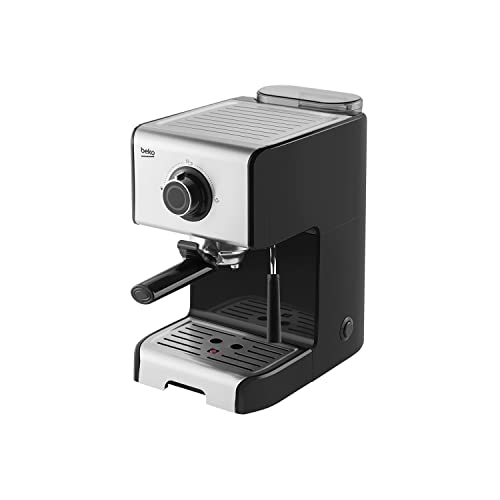Don't Believe These "Trends" Concerning Machine Espresso
댓글 :
0
조회 :
5
3시간전
 How Does Machine Espresso Work?
How Does Machine Espresso Work?The machine espresso uses precise pressure, as well as a filtering system that is awe-inspiring to create the coffee you love. But how exactly does it work?
To make espresso, hot water is forced under high pressure through finely ground coffee. The process is similar to making drip coffee, but the major difference is in the pressure.
The Head of the Group
As the name implies, the group head is where you put your portafilter in when making espresso. It is responsible for dispersing water into the portafilter and then controlling the pressure of the extraction. There are numerous kinds of group heads each with distinct advantages and disadvantages. Some focus on temperature stability, some on pre-infusion options, and others are designed to control the lever. Some include a combination like the E61. This is a very popular choice for baristas since it provides multiple advantages in one package.
As you can see from the photo above the group head is equipped with several notches. You place your portafilter inside these notches, and then twist the head to secure it. A gasket of rubber is situated inside the notches to help create a seal when you insert your portafilter. The notches allow for an exact placement of the portafilter. This is crucial to ensure an accurate extraction.
In addition to allowing you easily connect your portafilter, the group head is also responsible for maintaining a consistent temperature. It does this by cycling hot water through the brew basket and around the portafilter, making sure that it's always at the correct temperature for extraction. This is important, as just a few degrees could make the difference between a excellent and great espresso.
The Pump
In contrast to manual piston machines which rely on a lever to pressurize water, rotary espresso machines rely on motorized pumps that provide the nine atmospheric bars of pressure required to extract mini espresso machine Machine With Grinder (Https://Wiki.Gta-Zona.Ru/). This pressure is built up by pumping water through a heat exchanger and then through the ground coffee.
Pumps tend to be less expensive than piston-driven machines and tend to last longer, however both types of machines can degrade with overuse and insufficient cleaning. Pumps are also more complex mechanically, which can increase prices of even simpler models.
Certain espresso machines can eliminate the pump entirely and utilize steam pressure to make espresso. The drawback of this is that the same boiler that produces steam also raises the temperature of the water to boiling and can result in over-extraction. The machines also need to continuously rebuild their pressure between cups. This takes energy and time.
Many espresso machines employ either a rotary or vibration pump, which is a vibration model that uses a vibrating disc to generate the pressure, and an rotary model that pushes hot water through the grounds at high speed. Both models are capable of producing excellent espresso, but the rotary pumps are quieter, and espresso machine with grinder more durable than vibration pumps.
The Boiler
The boiler is used to heat the water to a temperature that is ideal to extract. The steam that is created is then directed to the portafilter, which holds the espresso grounds. The steam is then channeled into the cup. The steam generates enough pressure to push the grounds of coffee through. This creates a crema on the top of the espresso. This is the hallmark of a good espresso.
There are three types of espresso machines, each having different types of pumps and the temperature of the brew. There are a variety of ways to control the brew as well as the size of cup that can be made by the machine.
The earliest espresso machines were steam type. The earliest espresso machines were steam types. The coffee tasted bitter and burned. This is why the Milanese producers Luigi Bezzerra and Desiderio Pavoni developed the modern espresso machine.
The most well-known espresso machine is a semiautomatic model with an electric pump. When people think of espresso machines, they imagine these machines. Semi-automatic machines require you to grind and tamp the beans yourself, but the pump regulates the flow of water and pressure. This is a perfect combination of human control and mechanised reliability.
The Filter
Typically, espresso machines have a filter to separate out the coffee grounds as they pass through the hot water. The filter is also a vital component of the machine's temp control, as it helps prevent overheating.
It also improves flavor, as a filter lets you enjoy a longer bloom time. This lets the beans release their flavor and improves extraction.
However it is crucial to keep in mind that even a good filter can make a terrible cup of coffee, since the quality of the beans and extraction is still vital.
This is where the magic happens. It's what makes mini espresso maker taste great. The grouphead, also called the brew head, is the place where the portafilter (the device you put the ground coffee in) is located when you're making espresso machines home.
In the steam-driven espresso machine hot water is heated in an airtight tank to produce steam, which then pushes the hot water through the grounds under high pressure. These kinds of machines are usually less expensive and simpler to maintain than pump-driven models. However, they are not as efficient in their ability to produce the perfect brewing conditions as they only operate at 1-1.5 bars of pressure. The perfect shot requires 9-10 bar.
In recent times, espresso machines powered by compressed air-pump are becoming increasingly popular. They utilize an air compressor to push the hot water through the grounds, and are far more portable than steam-driven electric machines.


